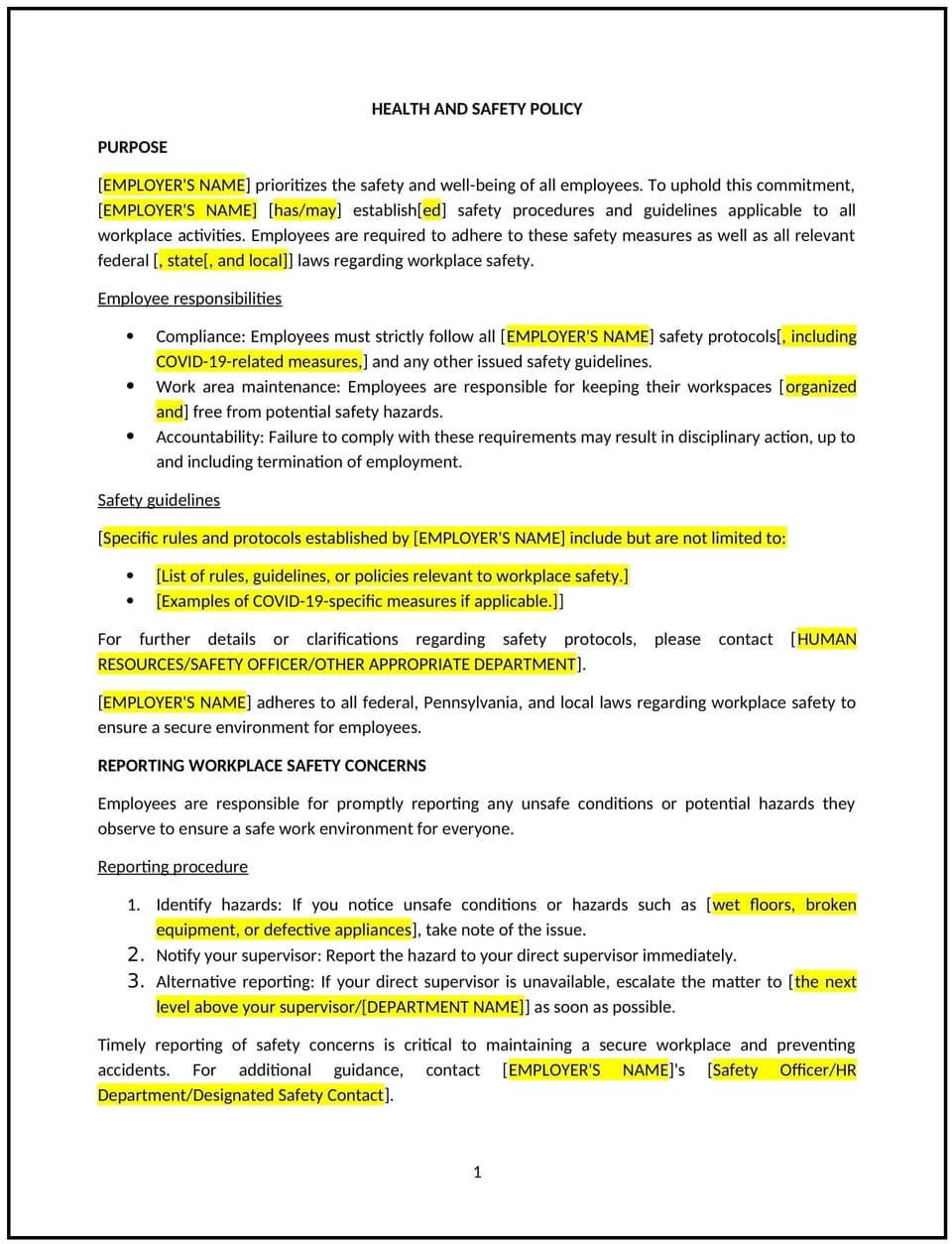Health and safety policy (Pennsylvania): Free template

Health and safety policy (Pennsylvania)
This health and safety policy is designed to help businesses in Pennsylvania establish guidelines to maintain a safe and healthy workplace for employees, contractors, and visitors. Whether operating in office environments, manufacturing, or other industries, this template provides clear instructions to identify, prevent, and manage potential hazards while aligning with federal and Pennsylvania-specific safety regulations, such as those enforced by the Occupational Safety and Health Administration (OSHA).
By using this template, businesses can promote workplace safety, support compliance with regulations, and reduce risks.
How to use this health and safety policy (Pennsylvania)
- Define safety responsibilities: Clearly outline the roles and responsibilities of employees, supervisors, and management in maintaining a safe workplace.
- Establish safety protocols: Provide detailed procedures for handling workplace hazards, such as fire safety, equipment usage, and emergency response.
- Include reporting procedures: Specify how employees can report workplace hazards, injuries, or unsafe conditions, including designated contacts and documentation requirements.
- Address training requirements: Detail the frequency and type of safety training employees must complete, such as first aid, equipment operation, or hazard recognition.
- Reflect Pennsylvania-specific considerations: Tailor the policy to address local workplace risks, industry standards, and state safety regulations.
Benefits of using a health and safety policy (Pennsylvania)
A well-structured health and safety policy supports a secure and productive workplace. Here's how it helps:
- Promotes workplace safety: Reduces the risk of accidents, injuries, and illnesses by establishing clear safety guidelines.
- Supports compliance: Aligns with OSHA standards and Pennsylvania-specific labor laws, reducing the likelihood of legal penalties.
- Enhances employee morale: Demonstrates a commitment to employee well-being, fostering trust and engagement.
- Encourages accountability: Provides employees and management with clear expectations for maintaining workplace safety.
- Reflects local needs: Addresses Pennsylvania’s unique industries and workplace risks, such as agriculture, manufacturing, or energy.
Tips for using a health and safety policy (Pennsylvania)
- Communicate expectations: Share the policy with employees and contractors during onboarding and provide easy access to updated versions.
- Provide regular training: Offer safety training tailored to specific job roles and risks, such as equipment handling or hazard identification.
- Conduct workplace inspections: Schedule regular safety audits to identify potential hazards and ensure compliance with the policy.
- Encourage reporting: Foster a culture where employees feel comfortable reporting hazards or unsafe conditions without fear of retaliation.
- Review periodically: Update the policy to reflect changes in Pennsylvania laws, federal regulations, or workplace practices.
Q: What safety measures are included in this policy?
A: The policy includes measures such as hazard identification, safety training, emergency response procedures, and clear reporting guidelines for workplace incidents.
Q: Who is responsible for maintaining workplace safety?
A: Safety is a shared responsibility among all employees, supervisors, and management, as outlined in the policy.
Q: How can employees report workplace hazards or unsafe conditions?
A: Employees can report hazards to their supervisor, safety officer, or HR department using the procedures detailed in the policy.
Q: What training is required under this policy?
A: Training requirements may include hazard recognition, emergency response, and role-specific safety protocols, depending on the nature of the workplace.
Q: How does this policy reflect Pennsylvania-specific considerations?
A: The policy aligns with OSHA standards and addresses workplace risks unique to Pennsylvania industries, such as mining, energy, or agriculture.
This article contains general legal information and does not contain legal advice. Cobrief is not a law firm or a substitute for an attorney or law firm. The law is complex and changes often. For legal advice, please ask a lawyer.


